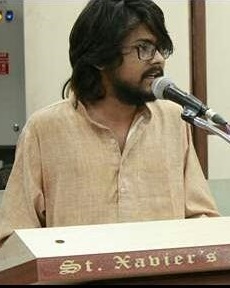Anshul Kumar
 “He who controls the past controls the future. He who controls the present controls the past” ~ George Orwell in 1984.
“He who controls the past controls the future. He who controls the present controls the past” ~ George Orwell in 1984.
Ever since the inception and evolution of mankind into a ‘modern human’ it has ever been the curiosity of the human mind to look around the surroundings in order to comprehend the esoteric and arcane nature of of ‘human existence’ and make sense out of ‘everything’ including ‘nothing’. This idea of looking towards every other phenomenon from our frame of reference stems from the idea put forward by Daniel Kahneman, “the fact that inner workings of human mind have ever been irrational and it is the undying spirit of our ‘grey cells’ which makes us to give meanings to our existence and the ‘cradle’ of our very existence itself.”
As put up by Engels in his ‘dialectics of nature’, he has hypothesised with astounding accuracy that the need for ‘media’ for ‘exchange of information’ has been there since the very beginning of human existence. He states that now that the humans were able to stand in an erect posture and walk around straight with their forearms not limited to aid them in perambulating, with the thumbs of their hands detached, the need arose as to how to communicate with fellow human beings and ask for succour in going about the ‘bare necessities of life’. This made it possible the development of vocal cords to an extent, where in humans were able to generate sounds of certain frequencies which were something more than just mere gestures.
This was the advent of what will later be making ‘man’ the most gregarious creation of this ‘cosmos’. Like many other things, gregariousness has proven to be a virtue of single largest importance for ‘man’. Subsequently this unintelligible speech found its way into a more refined form of oral gestures paving way for the traditions ‘oral traditions’ of communication and preserving our present experiences which will later came to be known as ‘our past’. The ‘oral’ medium of ‘information exchange’ was subject to getting lost into an oblivion during that epoch of humankind no such thing as a phonograph or any sound storing devices might have existed.
The only natural solution of this conundrum of archiving was ‘rote learning and memorisation’ of each and every bits and pieces of information more often than not forcefully and by attaching with it a sense of ‘divinity’ in order to avoid any mistake of losing out on anything important worth archiving. This was the first the first attempt to historicise ‘our past’ and the effective use of ‘media’ to subsequently pass on information to succeeding generations i.e. to say that it was a mode of ‘information exchange’ which was inherently hereditary. The best example of such a ‘media’ is the ‘Vedic’ way of life as envisioned by the ‘brahmins’ of South Asia who claimed for themselves and by themselves as the divinity itself on the Earth, who sprang out from the mouth of the creator himself, their lord, ‘Brahma’.
As far as the ‘Vedic’ way of life in the Ganga Jamuna Doab has been comprehended, all it consisted and initially based upon was the ‘personal narratives’ of the priestly caste, ‘the brahmins’ in invoking and praising their ‘Lords’ for their own well being on the Earth. Namely these ‘Lords’ were ‘Indra’, ‘Agni’ and ‘Soma’ as these three are mentioned more numerously others in the ‘Rig Veda’.
Now the question that can be asked is, how can one say that these ‘hymns’ praising the ‘Lords’ were acting as ‘media’? And that too not just a form of media whose function was limited to dissemination of archived information, but acted more often as a ‘sinister’ way of manipulating and appropriating ‘Indigenous‘ and ‘Dravidian’ cultures which were already in place prior to the establishment of a ‘Vedic’ order.
There are linguistic evidences to support this point of view of ‘media’ acting as an ‘alternate’ or even maybe the ‘legal penal code’ for the ‘society as a whole’ (society as a whole here takes into account the inhabitants who came directly into the folds of the chaturvarnya, and even those who were outside of this mode of ‘social stratification’ and were later collectively came to be known as the ‘panchamas’ or the fifth varna).
To quote Romila Thapar from one of her lectures presented via All India Radio, “It has been suggested, therefore that the later Vedic literature represents a cultural mingling of the speakers of the Indo-European language with those already settled in these areas. The linguistic evidence strongly suggests this idea. It is interesting that there are words of Dravidian origin in the Rig Veda.”
Romila Thapar has cited and corroborated this fact from T Borrow’s Sanskrit and MB Emanuel’s Collected papers.
Why Romila Thapar refers to this phenomenon of linguistic similarity as mere ‘cultural mingling’ should be kept aside for the time being so as to restrict myself to the interplay of ‘History’ and ‘Media’ and hypothesise my claim that the personal narratives of the ‘bhudevs’ were indeed altogether a sinister act of manipulation and appropriation of indigenous and Dravidian cultures.
In one of the hymns of mandal IV of the Rig Veda is the mention of the conquest of Vritra by Indra. While Indra was personification of the ‘Rain’ i.e. to say ‘available water resources’, Vritra personified drought. Vritra is referred to as a ‘demon-serpent king’ who took control of the ‘freshwater resources’ on the top of a mountain and is later defeated by Indra. This hymn states that possession of ‘water’ by this demon-serpent king rendered it ‘poisonous’.
Now if one looks at this description from a non-vedic lens and scrutinises it bit by bit, he or she can propose that the demon king represented some indigenous kingdom for whom freshwater was a natural resource essential for their survival and maybe it was Indra who unjustly seized that important resource from Vritra. This can also be construed from the fact that while in possession of Vritra, that resource was rendered poisonous. Here, poisonous may subtly connote the notions of purity and profanity, which have been inherent in vedic philosophy and have always been used to demean, subjugate and humiliate indigenous cultures. All this can be attributed to the effective use of ‘media’ to propagate ‘cultural hegemony’.
~~~
Anshul Kumar is doing his First Year Bachelor in Arts at St Xavier’s College, Mumbai. Originally from Delhi, his subjects here are Sociology, Ancient Indian Culture and Anthropology. He says he is a beginner in being an “Ambedkarite”, he aims to be an academic and teach sociology.










